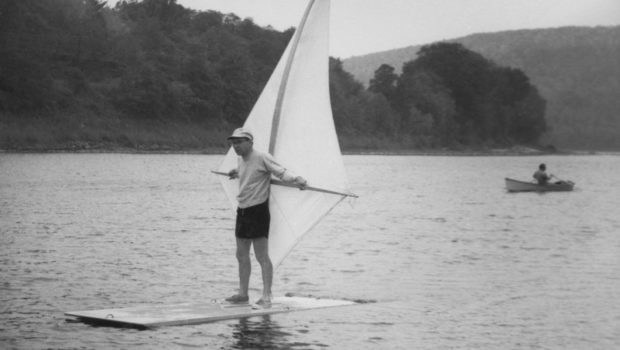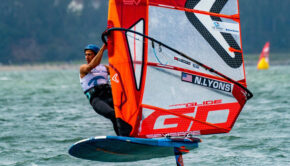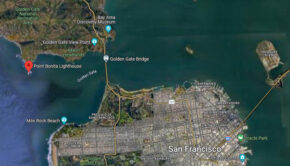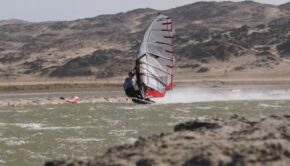The Original Originator of Windsurfing
Published on December 29th, 2016
It was surfing that led S. Newman Darby, a 20-something commercial artist and sign painter who had tinkered with sailboats, rowboats and other small watercraft since he was a child, to try to fly through the water with his hands on a sail.
The waves near his home in eastern Pennsylvania, on big lakes and even in the Atlantic Ocean, were considered too small for traditional surfing. So in the late 1940s Mr. Darby began swimming out into the water with a large canoe paddle, hopping onto his surfboard in the face of a brisk wind and holding the paddle aloft — both to pick up speed and, by adjusting the direction of its flat-faced blade, to steer himself toward shore.
On sailing trips with his girlfriend, a canoe racer whom he soon married, Mr. Darby refined the idea that in 1964 became the sailboard: a rudderless vessel that crosses elements of sailing and surfing and is credited with launching the sport of windsurfing.
Mr. Darby, who died Dec. 3 at 88 at his home in St. Johns, Fla., crucially received no patent for his design, and for many years was overlooked or altogether unknown to windsurfing enthusiasts and historians. Until the mid-1990s, the sport was associated mainly with two Californians, Jim Drake and Hoyle Schweitzer, who in 1970 were granted a patent for a similar design that they called the Skate, the Baja Board and then, fatefully, the Windsurfer.
Mr. Darby’s design, honed by him and Naomi Albrecht on a small lake near his home town of Wilkes-Barre, featured a kite-shaped sail atop a modified scow — a quick-moving, flat-bottomed sailing vessel with wide, square ends. To connect sail and scow, Mr. Darby fashioned an 18-inch length of nylon rope into a universal joint, allowing him to turn the sail in any direction and ride confidently in high winds. Albrecht, whom he married later in 1964, crafted the first sails.
Though difficult to master, the craft proved easy enough to learn — the scow was more stable than a surfboard, and its universal joint kept the sail from flying into the air in a gust — that by Christmas Mr. Darby decided to sell fiberglass sailboards commercially, at $295 each, with business help from his two brothers.
While continuing his sign-painting business, Mr. Darby gave some of the boards away on the television game show “The Price Is Right” and placed ads in the New York Times and in Popular Science magazine, where he wrote an accompanying four-page article complete with schematics illustrating the board’s construction.
“Sailboarding is sailing with a difference,” he wrote in the 1965 story. “You get all the fun of handling a fast, responsive boat. You can have the fun of spills without the work of righting and bailing out. And you can learn to master a type of maneuvering that’s been dead since the age of the picturesque square riggers.”
Mr. Darby sought a patent for his design, but — believing that his Popular Science story would demonstrate his claim to the universal joint and other details of the craft — gave up when the legal cost proved too high.
At the same time, board sales proved sluggish. In the next several years, Mr. Darby and his business, Darby Industries Inc., sold only about 80 of the boards before turning to the manufacture of truckhoes, backhoes and outdoor furnaces.
Hundreds of thousands of sailboards have since been sold, many of them through Drake and Schweitzer’s company Windsurfing International. When Mr. Darby and his wife recognized elements of their original design in the Windsurfer model, they contacted the U.S. Patent and Trademark Office. (Drake and Schweitzer said they had not read Mr. Darby’s original article; in one interview, Drake referred to himself as merely the sailboard’s “reinventor.”) The office told them they could invalidate the Windsurfer patent by writing formal letters to the agency and to Windsurfing International.
“I actually went home, wrote the two letters and had them in the envelopes,” Naomi Darby told American Windsurfer magazine in 1997. Lawyers told her and Mr. Darby not to send the letters, fearing an expensive legal fight.
The letters remained in their envelopes, unsent, and Mr. Darby’s focus returned to painting signs, including for Big Boy restaurants. His name surfaced in the 1980s, as part of a patent fight initiated by Windsurfer International against a competitor, but Mr. Darby sought little compensation for his invention, his daughter Wendy Darby Brown said in a phone interview.
“Getting rich was never his goal. Dad wanted people windsurfing all over the planet — and they did,” she said. Mr. Darby, she added, was satisfied once the sport that he helped create became part of the Olympics in 1984. Only then did he stop using the term “sailboarding.”
Sidney Newman Darby Jr. was born in Wilkes-Barre, Pa., on Jan. 31, 1928. His mother was a homemaker who ran a tea kitchen during the Depression, and his father was a sign painter who taught mechanical engineering at Pennsylvania State University during World War II.
Mr. Darby built his first boat, a rowboat that promptly sank, at 12, Darby Brown said. A folding rowboat he designed in 1953 and named the Darby Dory was more successful.
Mr. Darby moved to Jacksonville, Fla., in 1984 and continued windsurfing and working, designing catamarans and other vessels as a hobby, into his 70s. He died of cancer and other ailments, his daughter said.
In addition to his wife, of St. Johns, survivors include two daughters, Wendy Darby Brown of St. Johns and Cindy Tucker of Jacksonville; a younger brother, Ronald Darby, of Kaneohe Bay, Hawaii; and one grandson.
Mr. Darby’s role in the creation of windsurfing was highlighted beginning in the mid-1990s, when he notified American Windsurfer magazine that a long article about the history of windsurfing had omitted his contributions.
The magazine published a two-part interview with Mr. Darby and his wife, explaining the sailboard’s origins, and in 1998 the Smithsonian National Museum of American History acquired Mr. Darby’s archives, including mechanical drawings, and mounted an exhibition.
Photo: S. Newman Darby in 1964, on his first sailboard. Mr. Darby’s design for the board launched the sport of windsurfing. (Naomi Albrecht Darby/Smithsonian National Museum of American History)
Source: The Washington Post








 We’ll keep your information safe.
We’ll keep your information safe.